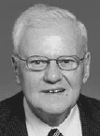|
|
|
 |
ABOUT THE PRESENTER |
Dr. Aaronson Dr. Aaronson is R. F. Mehl University Professor
Emeritus in the Dept. of Materials Science and
Engineering at Carnegie Mellon University.
He is also a Visiting Professor in the School of
Physics and Materials Engineering at Monash
University and an Adjunct Professor in the
Dept. of Materials Science and Engineering at
the University of Virginia.
He received his B.S., M.S. and Ph.D. degrees from Carnegie Institute
of Technology (now Carnegie Mellon Univ.). His specialty is the
morphology, mechanisms and kinetics of diffusional phase
transformations. Special emphasis has been placed throughout his
research on the migration of partly coherent interphase boundaries by
the ledge mechanism. He has published about 340 papers.
He is a Member of NAE, Fellow of TMS, Fellow of ASM and an
Honorary Member of the Japan Institute of Metals. His awards include
the C. H. Mathewson Gold Medal (TMS), Albert Sauveur Achievement
Award (ASM), Institute of Metals Lecture and R. F. Mehl Medal (TMS)
and the TMS Educator Award. Dr. Aaronson has been active on both
TMS and ASM committees and boards (especially the ASM-TMS
Phase Transformations Committee) and has been an organizer or
co-organizer of 15 published symposia.
|
Date: Monday, March 15, 2004
Time: 8:30AM
Location: Charlotte Convention Center
Room: 208A
“Low Energy and Low Mobility Structures at Irrational Interphase
Boundaries, and Compliance With Nucleation Theory”
 Presented
by: Presented
by:
Hubert I. Aaronson, Carnegie Mellon University
Sponsored by:
Electronic, Magnetic & Photonic Materials Division, Structural Materials Division, Jt. EMPMD/SMD -
Alloy Phases Committee and Phase Transformation Committee (Jt. ASM – MSCTS)
About the topic:
Nucleation theory has led to predictions that partially coherent
interfacial structures should develop during diffusional growth even at
irrational planar boundaries (ALK, 1968). This prediction is now tested
in alloy systems that appear to be successively less metallic in
character. In both a massively transformed Ag-26% Al alloy and during
precipitation at grain boundaries in Ti-Cr and Ni-Cr, nearly all interphase
boundaries are indeed partially coherent. However in the massive
transformations in near-TiAl and in MnAl(+2% C) alloys partially
coherent structures are largely absent (Vasudevan et al, Sofa et al.,
2002). Nie and Muddle (NM, 2002) and Howe, Reynolds and
Vasudevan (HRV, 2002) reported a preference for edge-to-edge
(Kelly and Zhang, 1999) rather than plane-to-plane matching of
certain low index planes in both lattices at facets in a Ti-46.54% alloy.
Recently Reynolds et al (2003) have shown with 3-D, NCDS modeling
that planar facets whose highly irrational crystallography was accurately
determined by NM and HRV correspond physically to dense parallel
rows of atoms intermingled in no obvious sequence but perhaps
displaceable only with Moire ledges, Li et al will report in this symposium
planar ZrN:alpha Zr-N facets whose structures cannot be rationalized
by edge-to-edge matching. This implies that other type(s) of irrational
interfacial structure capable of impending growth remain to be
discovered. Al:Xe(solid) interfaces, at which {111} Al and {100} Al
facets are present despite a misfi t of ca. 50% (Howe), suggest shallow
minima in the polar gamma-plot that affect only nucleation. This
spectrum of observations indicates that a marked difference in the
bond strength and character in the matrix and the product phases can
cause the two phases to play unequal roles in determining the crystallography and structure of low energy and low mobility
boundaries.
|

